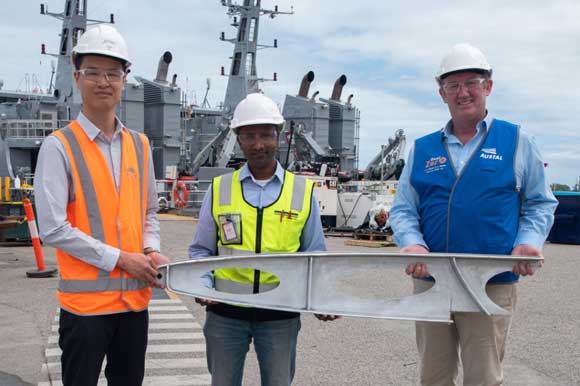AML3D and Austal Australia’s maritime AM crane receives verification from DNV
March 23, 2021

AML3D Limited, Edinburgh, Australia, reports that maritime AM parts developed in conjunction with global shipbuilder Austal Australia, Henderson, Australia, have received formal verification from DNV, a risk management and quality assurance provider based in Oslo, Norway. AML3D produced an aluminium personnel recovery davit (crane), intended for naval applications with its proprietary WAM® Additive Manufacturing technology, on behalf of Austal.
As part of the qualification process, a three-metre long personnel recovery davit was designed and additively manufactured to meet international and naval specifications. The assembly was then function tested to more than twice its design working load. Following the successful load test, as well as non-destructive and destructive testing, the results were reviewed by all parties before the final verification statement was issued.
The additively manufactured material (davit) was subjected to extensive testing by the John de Laeter Centre and the Curtin Corrosion Centre at Curtin University, Australia. Researchers utilised advanced microanalysis instrumentation to generate high-quality microstructural information and images. In addition, the mechanical and corrosion characteristics were assessed and compared against established marine grade metals.
Andy Sales, AML3D Chief Executive Officer, stated, “We’re proud to have been able to partner with Austal and demonstrate the advantages of our proprietary Wire Additive Manufacturing (WAM) capabilities in the creation of the Davit Arm. Additionally, we are equally as excited to see this WAM printed component receive an official verification statement by DNV. This now offers a verification pathway for a much wider range of components that can now follow a similar validation process.“
“This is a fantastic achievement by the AML3D team, Austal and our other partners in this project,” Sales continued. “Working with Austal’s vision for implementing Additive Manufacturing has been a further endorsement for our own business model and we’re excited for the future.”
Andrew Malcolm, Austal Chief Digital Officer, notes that the successful collaboration with AML3D and Curtin University on the AM project highlighted the many opportunities to pursue emerging technologies with the Australian industry.
Malcolm added, “Austal Australia has been working with AML3D since 2019 on the development of hybrid manufacturing approaches that put robotics side by side with our highly skilled tradesmen and women to fabricate large complex structures.”
“Wire Arc Additive Manufacturing, or WAAM, has the potential to enable a productivity step change in shipbuilding, able to 3D print marine grade metal structures at a scale well beyond other commercially available metal 3D printing technologies.”
“This DNV verification statement for the AM-produced personnel recovery davit shows that these Additive Manufacturing processes can meet our specification(s), which have been developed to fulfil the requirements to fit components to naval vessels, and we are certainly encouraged by the verification to pursue future opportunities,” Malcolm concluded.
AML3D sees this successful collaboration with Austal as a conduit to utilise the company’s WAM technology across a wide range of marine applications. Interest in the AM space has reportedly grown strongly in the sector due to inherently low production runs and the specialised nature of many marine parts.
It is expected that additional ‘proof of concept’ and accreditation processes will be completed with the wider industry during 2021 that have the potential to result in a significant order pipeline for AML3D.
















